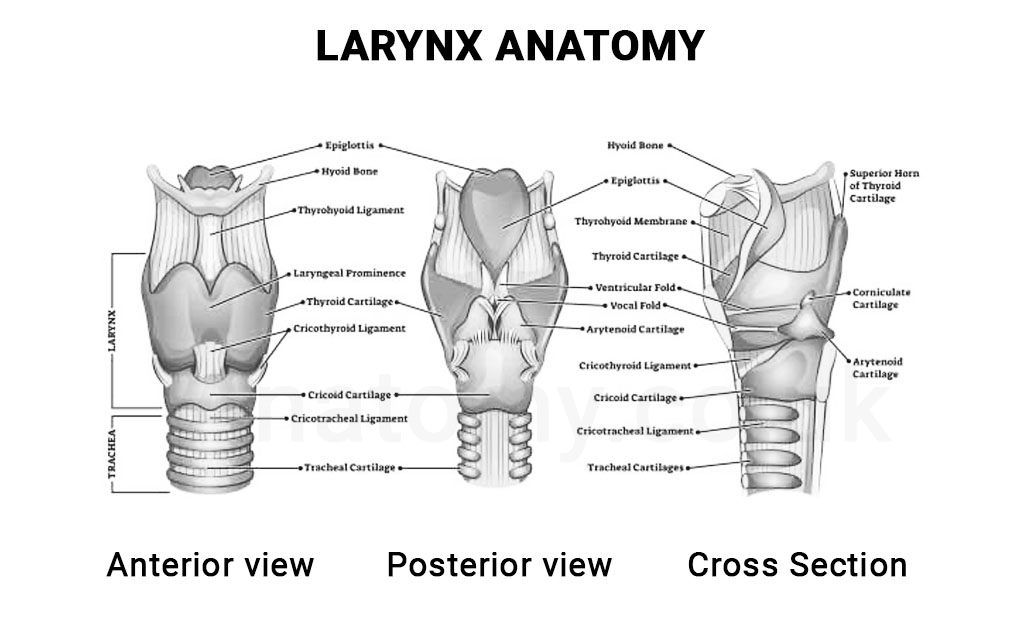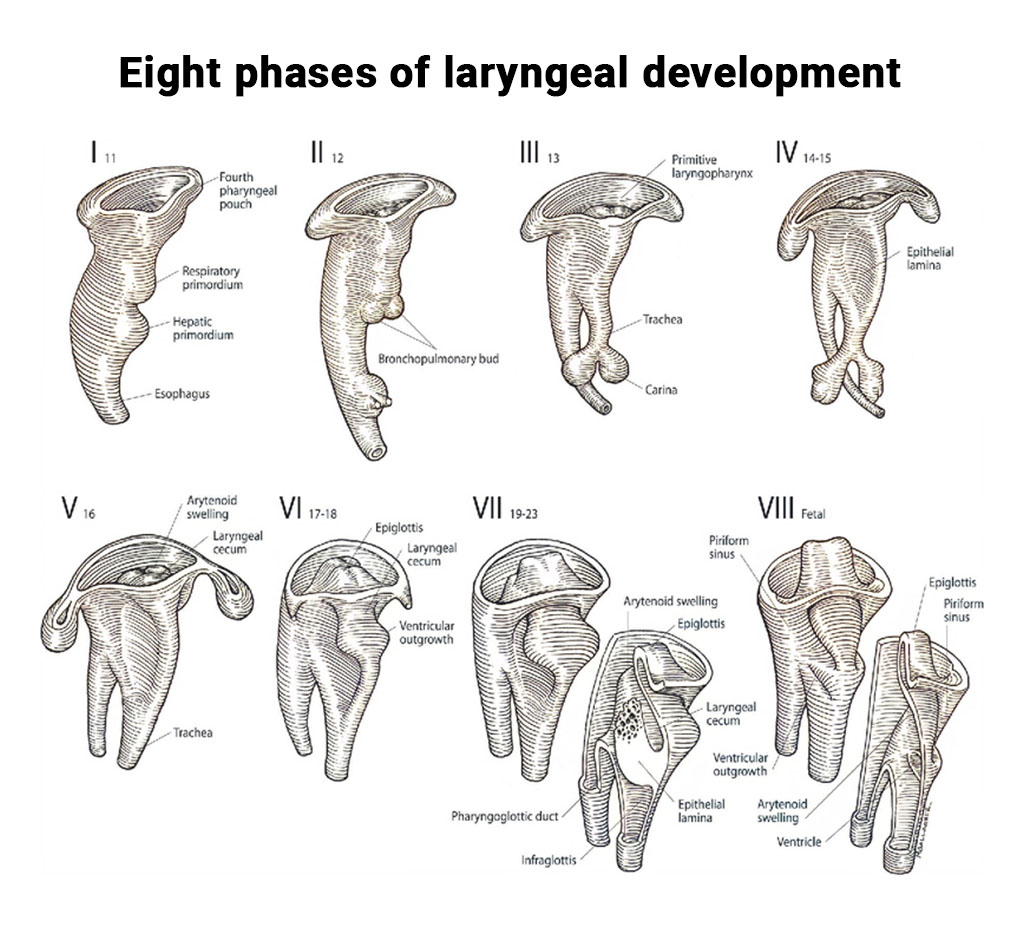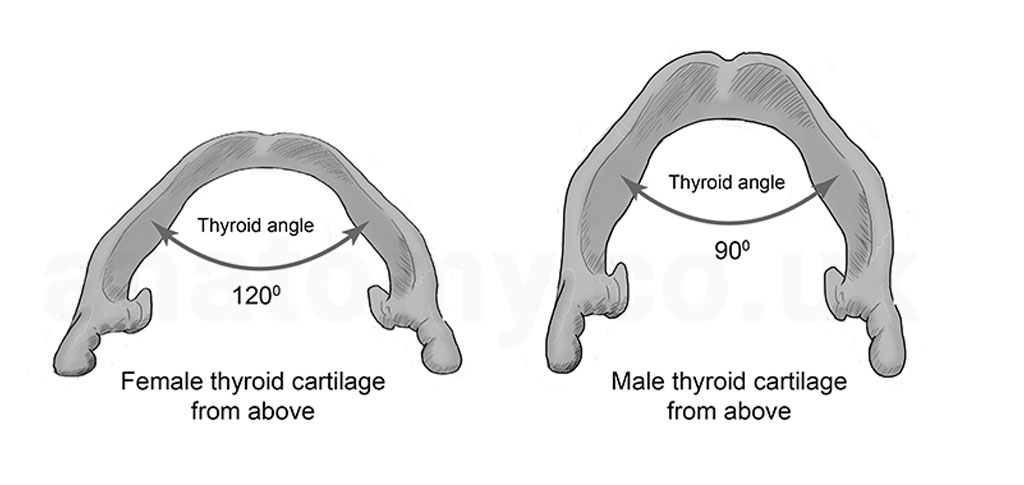TC
Thyroid Cartilage
Large cartilage forming anterior laryngeal wall
RegionHead and Neck
SystemRespiratory System
The thyroid cartilage is a prominent structure located in the anterior portion of the human neck. It is the largest of the nine cartilages that make up the laryngeal framework. Composed of hyaline cartilage, the thyroid cartilage serves as the main protective shield for the vocal cords, ensuring they remain undisturbed and in place for their vital function: voice production.
Commonly known as the "Adam's apple", especially when visible on the external neck, the thyroid cartilage can vary in size and prominence between individuals. It plays a significant role in voice modulation due to its intimate association with the vocal cords and surrounding musculature. Additionally, its positioning at the front of the neck provides essential protection to the airway and related internal structures.
Anatomy of the Thyroid Cartilage

Image 1: Thyroid cartilage anatomy diagram
The thyroid cartilage, as a primary component of the laryngeal structure, possesses specific anatomical features that allow it to perform its protective and supportive functions.General Structure
The thyroid cartilage is composed of two plate-like structures called laminae. These laminae meet in the midline, forming the laryngeal prominence, which is more commonly referred to as the "Adam's apple". This prominence is generally more pronounced in males due to hormonal influences during puberty which cause it to enlarge.Laryngeal Prominence (Adam’s Apple)
Situated anteriorly, the laryngeal prominence is the most visible and palpable part of the thyroid cartilage. Its degree of prominence can vary between individuals, often being more noticeable in males than in females.Superior and Inferior Horns (Cornua)
Projecting upwards from the main body of the thyroid cartilage are the superior horns (cornua). These horns articulate with the hyoid bone, which lies above the thyroid cartilage. Conversely, the inferior horns extend downwards and articulate with the cricoid cartilage beneath.Thyroid Notch
Located at the topmost part of the laryngeal prominence, the thyroid notch represents the highest point of the thyroid cartilage. This U-shaped notch serves as a point of attachment for several important ligaments and muscles associated with the larynx.Thyrohyoid Membrane
This is a broad, fibro-elastic sheet that connects the thyroid cartilage to the hyoid bone. It provides flexibility and support to the structures it bridges, ensuring smooth movement during swallowing and speaking.Angles and Facets
The posterior edge of each lamina has two distinct angles, an upper and a lower, which provide sites of attachment for muscles and ligaments essential for the movement and stability of the larynx.Relation to Other Neck Structures
The thyroid cartilage is located anteriorly to the vocal cords and the glottis. It is positioned superior to the cricoid cartilage and inferior to the hyoid bone. The space between the thyroid cartilage and the cricoid cartilage below is termed the cricothyroid space, which is clinically significant, especially in emergency airway management procedures.
Image 2: Larynx anatomical illustration diagram
Development and Variation
Understanding the development and variations of the thyroid cartilage is essential in recognizing its function and significance in different age groups and between sexes.
Image 3: Laryngeal development stages illustration
Embryological Development
The thyroid cartilage begins its formation in the fourth embryonic week from the fourth branchial arch. As development progresses, these mesenchymal condensations enlarge, fuse, and gradually chondrify to form the distinctive shield-like structure of the thyroid cartilage by the end of the fetal period.Pubertal Changes
During puberty, under the influence of testosterone, the thyroid cartilage, especially the laryngeal prominence, undergoes significant enlargement in males. This growth results in the increased prominence of the Adam's apple in post-pubertal males as compared to females. The enlargement also coincides with the deepening of the male voice, as the vocal cords lengthen and thicken.Gender Differences

Image 4: Male vs female laryngeal prominence
Beyond the noticeable difference in the size of the laryngeal prominence between males and females, the angle at which the two laminae of the thyroid cartilage meet (thyroid angle) also differs. In males, this angle is more acute, typically around 90 degrees, whereas in females, it's more obtuse, often greater than 120 degrees.Age-related Changes
As with many structures in the body, the thyroid cartilage undergoes changes with age. Over time, there's a progressive calcification and, in some cases, ossification of the cartilage. This makes it less elastic and more rigid in elderly individuals. Such changes can impact voice quality and flexibility of the laryngeal structures.Anatomical Variations
Occasionally, there might be individual variations in the anatomy of the thyroid cartilage. For instance, some people might have an incomplete fusion of the laminae in the midline, leading to a small gap or notch at the upper edge of the laryngeal prominence. While these variations are typically benign, it's important to be aware of them, especially in clinical evaluations.Functions
The thyroid cartilage, being the largest of the laryngeal cartilages, has a crucial role in ensuring the proper function and protection of the vocal apparatus and the larynx. Here's a breakdown of its main functions and why they are so vital:Protective Shield
The primary function of the thyroid cartilage is to protect the vocal cords and the laryngeal inlet. Its prominent and sturdy structure acts as a barrier against external physical impacts, safeguarding the delicate vocal cords and associated structures from potential injury.Voice Production
While the thyroid cartilage itself doesn't produce sound, its positioning and interaction with the vocal cords are pivotal for voice production. The tension and length of the vocal cords, which influence pitch and tone, are partly determined by the angle and position of the thyroid cartilage. Movements of the thyroid cartilage, especially its tilting, play a role in modulating vocal pitch by adjusting cord tension.Support to the Larynx
The thyroid cartilage offers structural support to the larynx, maintaining its shape and ensuring the correct positioning of other laryngeal cartilages and muscles. This structural integrity is essential for coordinated movements during speaking, breathing, and swallowing.Point of Muscle Attachment
Several intrinsic and extrinsic laryngeal muscles attach to the thyroid cartilage, including the cricothyroid and thyroarytenoid muscles. These muscles are involved in adjusting the tension, position, and length of the vocal cords, hence the thyroid cartilage's surface acts as a crucial anchor point facilitating these adjustments.Clinical Significance
Injuries and Disorders: Given its anterior position in the neck, the thyroid cartilage can be vulnerable to traumatic injuries, like blunt trauma or penetrative wounds. Such injuries can lead to fractures or disruptions, affecting voice quality and possibly the airway. Surgical Interventions: The thyroid cartilage often comes into focus during laryngeal surgeries, especially in cases related to laryngeal cancer. Its prominence also makes it a landmark for certain procedures like thyroplasty, which aims to improve voice quality. Cricothyrotomy: In emergency situations where the upper airway is blocked, and intubation isn't possible, the cricothyroid membrane, located between the thyroid and cricoid cartilages, can be punctured to establish an emergency airway, a procedure known as cricothyrotomy. Diagnostic Imaging: Issues involving the thyroid cartilage, like fractures or tumors, can be visualized using imaging techniques like X-rays, CT scans, or MRIs. Calcification of the cartilage can be an incidental finding in older individuals.Interesting Facts and Myths
Adam’s Apple Origins: The term "Adam's apple" is believed to have biblical origins. According to one interpretation, it represents the forbidden fruit, often depicted as an apple, that Adam ate in the Garden of Eden, which got stuck in his throat. Not Just a Male Trait: While the Adam's apple is often associated with males, females also have a thyroid cartilage. In females, it's generally less prominent due to differences in angle and size.[4] Cosmetic Reduction: Some people opt for surgical procedures, known as chondrolaryngoplasty, to reduce the prominence of the Adam's apple, especially in gender-confirming surgeries for transgender women. Voice Deepening and the Adam's Apple: A common myth is that a larger Adam's apple guarantees a deeper voice.[2] While there's a correlation between the size of the thyroid cartilage and voice depth, especially post-puberty in males, other factors like vocal cord length and thickness play a role too.Frequently Asked Questions
Why is it called the thyroid cartilage?
The term "thyroid" originates from the Greek word "thyreos," which means "shield." The thyroid cartilage is named so because of its shield-like shape, which protects the vocal cords and the laryngeal inlet.[7]Can the size of the Adam’s apple be reduced?
Yes, a surgical procedure known as chondrolaryngoplasty can be performed to reduce the prominence of the Adam's apple.[5] This procedure is commonly sought by transgender women during gender-confirming surgeries but can also be done for cosmetic reasons.Why is the Adam’s apple more prominent in men than in women?
During puberty, under the influence of testosterone, the thyroid cartilage enlarges in males, making the Adam’s apple more pronounced. [3]Additionally, the angle at which the laminae of the thyroid cartilage meet is sharper in males, contributing to its prominence.Does a larger Adam's apple mean a deeper voice?
Not necessarily. While the size of the thyroid cartilage can influence voice depth, especially in males post-puberty, the depth of one's voice is also determined by other factors like the length and thickness of the vocal cords.[1]Is it normal for the thyroid cartilage to move when swallowing?
Yes, it's entirely normal. When you swallow, the larynx (and therefore the thyroid cartilage) moves upwards to facilitate the passage of food or liquid. This movement also aids in closing off the windpipe temporarily, preventing aspiration.Can the thyroid cartilage become ossified with age?
Yes, with advancing age, the thyroid cartilage, like other cartilages in the body, can undergo calcification or even ossification. This results in decreased elasticity and increased rigidity of the cartilage.Published on October 9, 2023
Last updated on May 11, 2025
Last updated on May 11, 2025